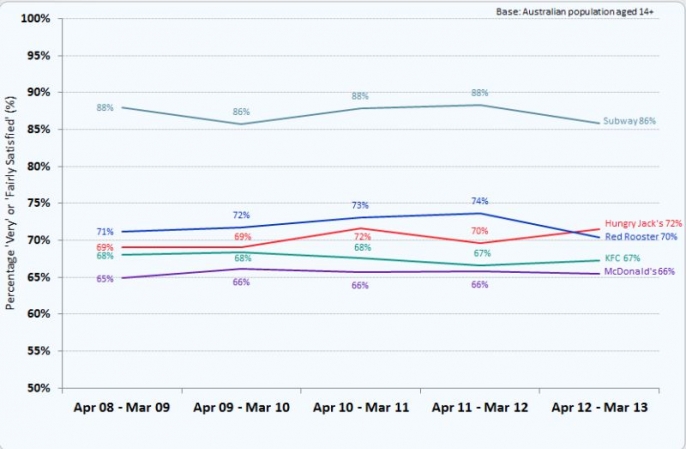Two fast food brands prove the long term value of a challenger positioning
There are few categories more sophisticated at marketing than fast food. For 50 years McDonalds has been fine-tuning their brand marketing driven machine in Australia. Other brands may talk share of voice or share of wallet, McDonalds is famous for wanting the largest share of stomach in the country.
The business is a great example of how to upsell, cross sell and find new reasons for customers to visit. From breakfast muffins through burgers and happy meals to soft serves and late night treats, washed down by McCafe coffees in between. From Pasta Zu to chicken nuggets to who knows what else a machine can transform animal castoffs into.
Want fries with that?
All of these tactics are an excuse to get more people to buy fries more often, it's where the big profits are made. Makes you wonder how anyone can compete? If you don't work for an omnipotent global business there is evidence of hope. Roy Morgan reasearch released in August 2013 shows just how well new competitors can do by choosing to take a challenger brand positioning.
A case study in how positioning can outsmart the big brands
Hungry Jacks came much later, and has never had the footprint or the ad budget to compete head on. What has worked long term for Jack Cowin's fast food challenger up against a global heavyweight, is a differentiated positioning that gives it a clearly defined space to compete in. "The burgers are better at Hungry Jacks."
From day one they lived up to that positioning statement, better burgers; either with biigger burger patties, actual lettuce instead of a miserable pickled cucumber, to the first Angus beef burger, then bacon and now organic beef. Single mindedly niche focused, and better for it in the minds of customers, who consistently rank Hungry Jacks above Maccas.
Long-term customer satisfaction in fast food comes from smart positioning. Chart: Roy Morgan, August 2013

Challenger brands create new terms to compete on
Subway shows the rewards of zigging when the competition zags. While fast food leaders spent their product and promotion strategies on short term price promotion or new themes, from changing with the seasons, think summer pineapple burgers to following fashions, think cajun sauce. Meanwhile Subway went where no fast food had ever successfully gone before: the good for you. positioning.
The chart shows the relative strength of Burger King's "do less of the same, better" approach, and Subway's "do something completely different" model. Both are positively recognised by the consumer and continue to command a price premium to the slower to innovate fast food competition.



Scan the QR code for our contact details.
Download the Neoreader app.
© COPYRIGHT 2013 UNO marcomms Privacy